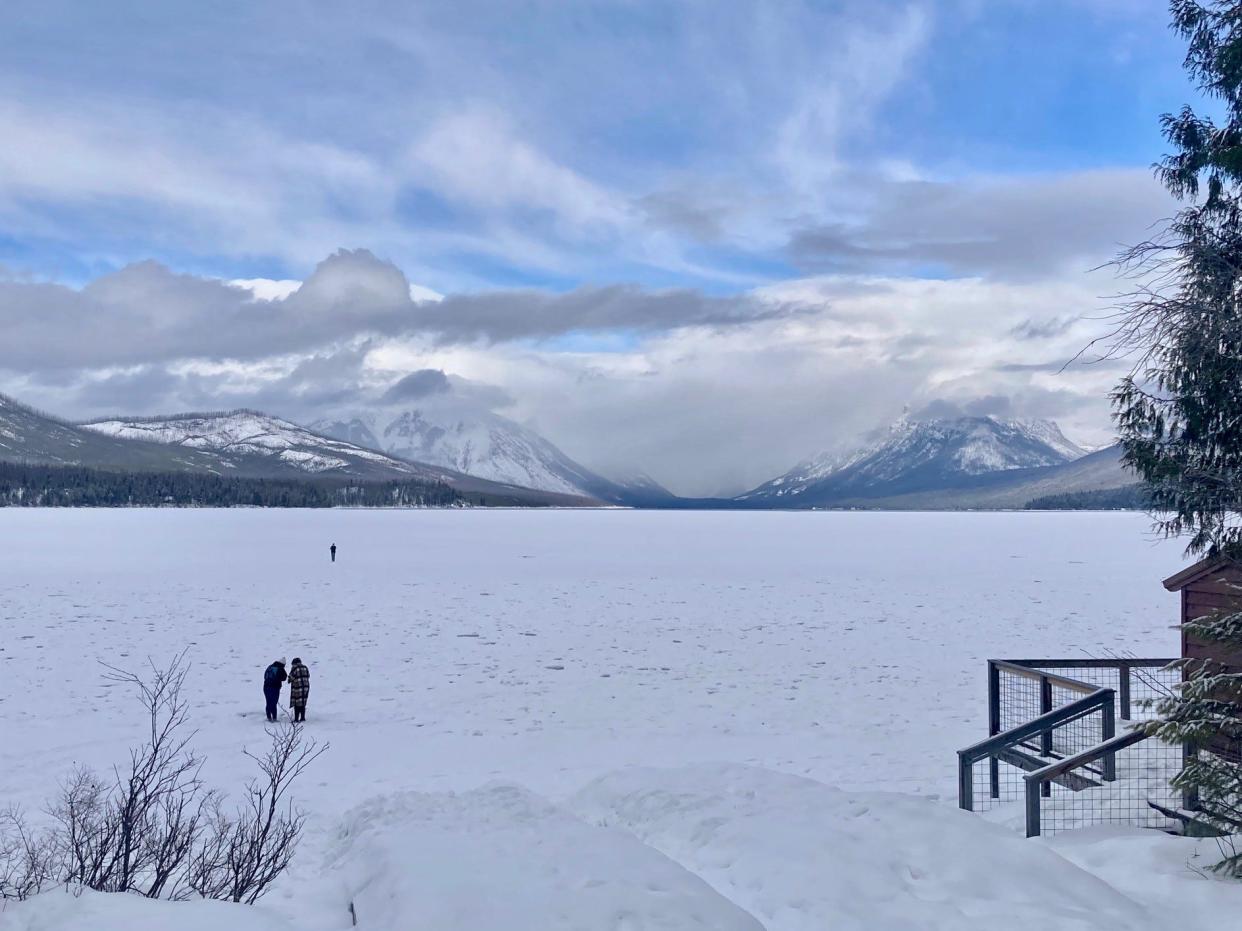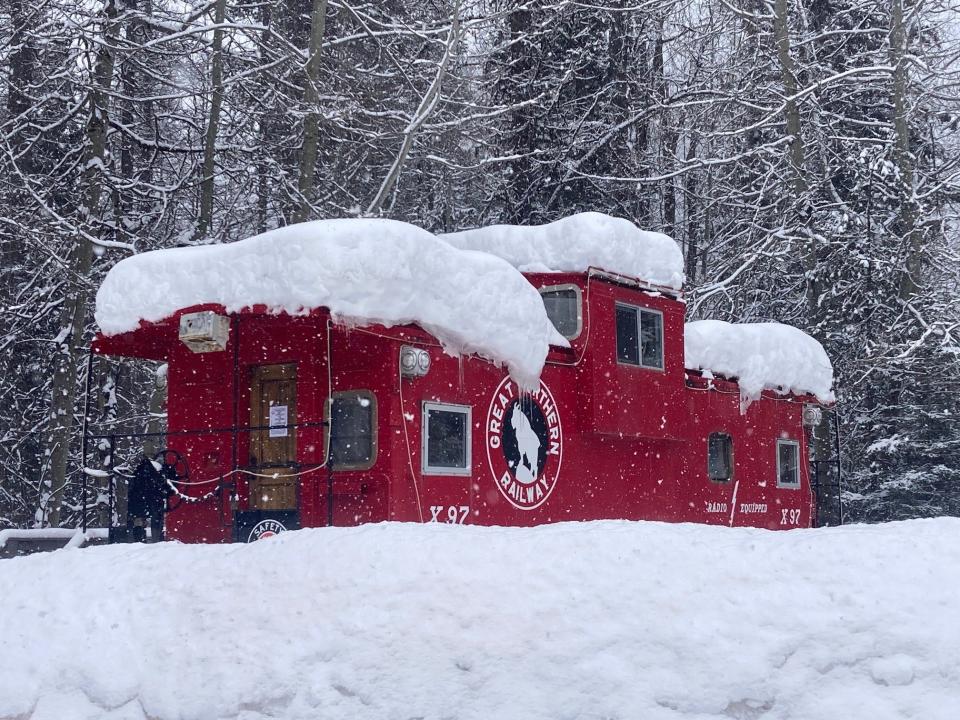Glacier National Park: Cold, spectacular and almost deserted in winter

Over the past week, we visited Whitefish, Montana, for a National Ski Patrol alumni gathering and used two days to explore nearby Glacier National Park. In a few words, the park is cold, spectacular, memorable and lonely. Whitefish is a lovely ski town, just below a major ski resort, Whitefish Mountain, and is just 25 miles west of West Glacier. The park receives only about 1% of the visitation in winter, compared to the crowds that jam the park from May through mid-October.
Glacier in winter allows drive-in access from the west entrance to the Apgar Village and Campground (a single loop of the huge campground is open for winter campers) and 11 miles of the Going to the Sun Highway beside Lake McDonald. The highway is usually plowed to Lake McDonald Lodge, where the highway is routinely closed by winter snows. Unhappily, a construction project had that section of the road closed, so we couldn’t course up the south side of the lake. Still, views from different vantage points on the lake’s west-end, looking northeast up this lovely lake into Glacier’s rugged, snowy peaks, is unforgettable.
On our first day (in the three hours within the park) we saw eight other people. Exiting the park, we doubled back to Columbia Falls and headed north up Montana Highway 486, hoping to make the tiny town of Polebridge (and Polebridge Mercantile’s storied cinnamon rolls) on the park’s west side, but deep snows ended our exploration after 20 miles; the views added to our treasured collection. The next day, we toured a group of 20 ski patrol alumni into the park, probably doubling the park’s daily visitation count. On the park's east side, roads are cleared only 1.5 miles west of the Saint Mary Visitor Center. Views here are also stunning, despite limited road access; cross country skis or snowshoes allow you deeper park access (no snow mobiles are allowed inside the park).
We spotted two cross-country skiers along marked trails around Apgar Village, which fan-out along McDonald Creek and the lakefront. Additional cross country and snowshoe trails also offer options along the northern edge of Lake McDonald. When the road is open to Lake McDonald Lodge, skiers/snowshoers can continue up the closed Going to the Sun Highway; those with real energy and back-country experience could continue another 20 miles to Logan Pass.
But for several tents in the huge Apgar campground, we had the place all to ourselves. Two mule deer provided comic relief, skittering across a closed, icy road and into the woods. Had I been smart enough to bring my binoculars, I suspect several of the large raptors soaring overhead were bald eagles.

U.S. Highway 2 skirts the southern edge of this huge park, and we motored halfway across the southern park boundary to the tiny town of Essex and the Izaak Walton Inn, a 1939 Great Northern Railway hotel converted to guest lodging, offering 30 rooms in the hotel and converted cabooses and locomotives spread throughout the woods. The Inn offers 21 miles of cross country and snowshoe trails fanning out into the park’s southern reaches. Meals in the inn’s dining room are a treat, and a night spent in an old caboose a lovely treasure.
We spent four nights in the Grouse Mountain Lodge on the western edge of Whitefish, a handsome old lodge with reasonable prices and attentive staff, with an on-site bar and restaurant. Whitefish is a lively and cool ski town, with wonderful restaurants like the Whitefish Lake Golf Club Lodge, Abruzzo’s Italian Kitchen, The Craggy Range Bar and Grill and The Boathouse on Whitefish Lake. Brewpubs, winetasting shops and distilleries dot the downtown add to the scene. Western and specialty shops abound, and every type of outdoor outfitters are represented in the downtown area and surrounding highways.
A few years ago we took the most memorable dog sled ride, offered by Dog Sled Adventures Montana in the town of Olney, about 19 miles west of Whitefish on Highway 93. A team of seven Huskies and an attentive musher took my wife and me on a rollicking ride through the surrounding Montana State Forest. Several guest ranches also offer sleigh rides, another fun diversion.
The Great Northern Railway/Amtrak Station is home to the intriguing Stumptown History Museum depicting the early days of both the city and the railroad. Just opened is the Ski Heritage Center, in the historic Saddle Club Cabin next to the Stumptown Ice Den, providing exhibits of skiing in the days before the opening of Big Mountain Resort (now Whitefish Mountain). Both museums offer unique intrigue to lovers of history and the “old days.”
Hardy Montana travelers also have the option of motoring southbound to Yellowstone National Park, about a seven hour drive away, into either the north entrance to Mammoth Hot Springs, or to West Yellowstone on the parks west side (see my recent article on this, America’s first national park).
What to take: Binoculars and camera, of course, all of your cold-weather clothing, and skis or showshoes if inclined. Pack chains for your vehicle, even if you have a 4-wheel drive; jumper cables if temps are predicted to -20 or lower.
Where to stay: In Whitefish, the Grouse Mountain Lodge (grousemountainlodge.com; on the southern edge of Glacier Park; a unique inn is the Izaak Walton Inn (izaakwaltoninn.com).
For more information on Dog Sled Adventures Montana, dogsledadventuresmontana.com; Glacier National Park, nps.gov/glac/planyourvisit/winter.htm; Whitefish visitation, explorewhitefish.com; Whitefish Mountain ski resort, skiwhitefish.com.
Contact Tim, tviall@msn.com. Happy travels in the West!
This article originally appeared on The Record: Glacier National Park: Cold, spectacular and almost deserted in winter

